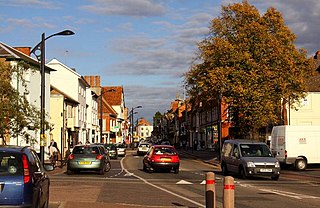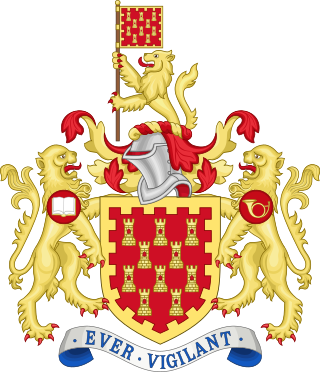Mark Clapson is a British social and cultural historian specialising in suburban history, the Blitz and working-class history. As of 2017, he is professor of social and cultural history at the University of Westminster.
Mark Clapson is a British social and cultural historian specialising in suburban history, the Blitz and working-class history. As of 2017, he is professor of social and cultural history at the University of Westminster.
Clapson graduated from Lancaster University with a Bachelor of Arts (BA) degree in 1982, and then received a Master of Arts (MA) degree in modern social history from the University the following year. In 1989, he was awarded a doctorate (PhD) from the University of Warwick, having successfully defended his thesis on gambling in England between 1823 and 1961. [1]
Having taught at the Open University and the University of Bedfordshire, [1] Clapson joined the University of Westminster in 2002; [2] as of 2017, he is a Professor of Social and Cultural History there. [1]
Clapson has also served on the Arts and Humanities Research Council Peer Review College, the Steering Committee of History UK and the Editorial Boards of Planning Perspectives , the University of Westminster Press and the Journal of Administrative Sciences. [1]
Clapson's research has focused on the history of suburbia in England, as well as working-class and leisure history, and the history of the Blitz. [1] According to a Research Excellence Framework case study, he "has challenged a powerful anti-suburban prejudice in popular and elite cultures in Britain, and sought to confront negative perceptions of the British new towns. His impact is international in reach." [2] Clapson has focused on the intersection between planning policy and social change in an international context, arguing that Milton Keynes "was at the crossroads of an Anglo-American intellectual culture of town planning". [2]

Buckinghamshire, abbreviated as Bucks, is a ceremonial county in South East England that borders Greater London to the south-east, Berkshire to the south, Oxfordshire to the west, Northamptonshire to the north, Bedfordshire to the north-east and Hertfordshire to the east.

Milton Keynes is a city and the largest settlement in Buckinghamshire, England, about 50 miles (80 km) north-west of London. At the 2021 Census, the population of its urban area was over 256,000. The River Great Ouse forms its northern boundary; a tributary, the River Ouzel, meanders through its linear parks and balancing lakes. Approximately 25% of the urban area is parkland or woodland and includes two Sites of Special Scientific Interest (SSSIs).

Newport Pagnell is a town and civil parish in the City of Milton Keynes, Buckinghamshire, England. The Office for National Statistics records Newport Pagnell as part of the Milton Keynes urban area.

Bletchley is a constituent town of Milton Keynes, Buckinghamshire, England. It is situated in the south-west of Milton Keynes, and is split between the civil parishes of Bletchley and Fenny Stratford and West Bletchley.
Fenny Stratford is a constituent town of Milton Keynes, Buckinghamshire, England and in the Civil Parish of Bletchley and Fenny Stratford. Originally an independent town, it was included in the Milton Keynes "designated area" in 1967. From 1895 it formed an urban district with Bletchley, until 1974 when it became part of the (then) District of Milton Keynes. It is located at the southern edge of the city, just east of Bletchley and west of the A5.

Lathbury is a village and civil parish in the City of Milton Keynes, Buckinghamshire, England. It is just to the north of Newport Pagnell and just outside the Milton Keynes urban area.

Stony Stratford is a constituent town of Milton Keynes, Buckinghamshire, England. Historically it was a market town on the important route from London to Chester. It is also the name of a civil parish with a town council in the City of Milton Keynes. It is in the north-west corner of the Milton Keynes urban area, bordering Northamptonshire and separated from it by the River Great Ouse.

Chantal Mouffe is a Belgian political theorist, formerly teaching at University of Westminster.

The Greater Manchester County Council (GMCC) was the top-tier local government administrative body for Greater Manchester from 1974 to 1986. A strategic authority, with responsibilities for roads, public transport, planning, emergency services and waste disposal, it was composed of 106 directly elected members drawn from the ten metropolitan boroughs of Greater Manchester. The Greater Manchester County Council shared power with ten lower-tier district councils, each of which directed local matters. It was also known as the Greater Manchester Council (GMC) and the Greater Manchester Metropolitan County Council (GMMCC).
Milton Keynes Development Corporation (MKDC) was a development corporation operating from 1967 to 1992 oversee the planning and early development of Milton Keynes, then a planned new town midway between London and Birmingham.
Urban history is a field of history that examines the historical nature of cities and towns, and the process of urbanization. The approach is often multidisciplinary, crossing boundaries into fields like social history, architectural history, urban sociology, urban geography, business history, and archaeology. Urbanization and industrialization were popular themes for 20th-century historians, often tied to an implicit model of modernization, or the transformation of rural traditional societies.

This history of Milton Keynes details its development from the earliest human settlements, through the plans for a 'new city' for 250,000 people in northern Southeast England, its subsequent urban design and development, to the present day. Milton Keynes is the largest settlement and only city in Buckinghamshire, founded in 1967. At the 2021 census, the population of its urban area was estimated to have exceeded 256,000.
Melvin M. Webber was an urban designer and theorist associated for most of his career with the University of California at Berkeley but whose work was internationally important. He was a director of the university's Transportation Center, an author of classic theoretical papers and of major consulting reports, and an active contributor to debates on transportation policy, regional development and planning theory.

Paul Alexander Slack FBA is a British historian. He is a former principal of Linacre College, Oxford, pro-vice-chancellor of the University of Oxford, and professor of early modern social history in the University of Oxford.

An overspill estate is a housing estate planned and built for the housing of excess population in urban areas, both from the natural increase of population and often in order to rehouse people from decaying inner city areas, usually as part of the process of slum clearance. They were created on the outskirts of most large British towns and during most of the 20th century, with new towns being an alternative approach outside London after World War II. The objective of this was to bring more economic activity to these smaller communities, whilst relieving pressure on overpopulated areas of major cities. The Town Development Act 1952 encouraged the expansion of neighbouring urban areas rather than the creation of satellite communities. The authorities wished to divert people living in poor conditions within highly populous cities to better conditions on the outskirts of these cities. Overspill not only involves moving people to a new area, but requires industry and employment to follow. Often the industries and resources took longer to migrate than the people, hence there were a number of issues surrounding early overspill projects. Slum clearance tenants often had problems with the move, since it separated them from extended family and friends, needed services were often lacking, and only the better off workers could afford the extra cost of commuting back to their jobs. Another criticism was that the new estates occupied what had been productive agricultural land.
The New Towns movement refers to towns that were built in the United Kingdom after World War II and the associated social movement to advocate for their construction. These towns were planned, developed, and built with two main intentions: to remedy overcrowding and congestion in some instances, and to organize scattered ad hoc settlements in others. The bigger purpose of this development was to decongest larger industrialised cities, and to rehouse people in freshly built, fully planned towns that were completely self-sufficient for the community.

Fred Bernard Pooley CBE is best known as the county architect of Buckinghamshire, and his futuristic monorail proposals for a new town in north Bucks that eventually became Milton Keynes. Pooley was born in West Ham, east London and trained at the Northern Polytechnic in the evenings, while working in the West Ham engineer's department by day. He qualified as an architect, planner and surveyor before serving with the Royal Engineers during World War II. He also qualified as a structural engineer and arbitrator.
Max Lock (1909–1988) was a British postwar urban planner who emphasised the importance of incorporating social research in the planning process. His most notable contributions were associated with planning in Middlesbrough, where he worked with Griselda Rowntree and Ruth Glass on the 1944 Middlesbrough Survey, and Hull. Lock's Hull work achieved acclaim with a 1943 London exhibition at the Housing Centre opened by the Minister of Town and Country Planning and in The Architects' Journal.
Monica Felton was a British writer, town planner, feminist and social activist, a member of the Labour Party.
Large numbers of British civilians engaged in trekking during the Blitz. This involved leaving cities at night to sleep in nearby towns and rural areas. The practice was most prevalent in provincial cities during early 1941. While the British Government was concerned that trekking indicated that civilian morale was under strain, the practice was generally motivated by a desire to avoid the risk of death or injury and to be able to sleep.